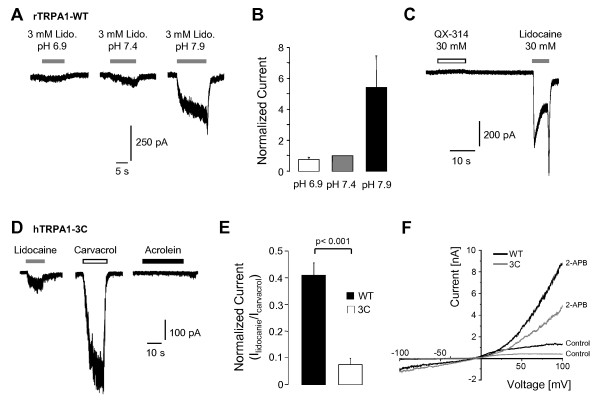Figure 4.
Intracellular interaction sites of lidocaine on TRPA1. A. Current traces of wildtype rTRPA1 activated by 3 mM lidocaine at pH 6.9, 7.4 or 7.9. Lidocaine-solutions with different pH-values were applied on the same cells in intervals of 1 min. B. Relative current amplitudes of rTRPA1 activated with 3 mM at different pH-values. The absolute current amplitudes were normalized to the amplitude determined for pH 7.4. C. Typical effect of the impermeable lidocaine-derivative QX-314 on rTRPA1. 30 mM QX-314 did not evoke any current responses in TRPA1-expressing HEK293t cells in which 30 mM lidocaine evoked large inward currents. Cells were held at -60 mV. D. Representative experiment performed on the acrolein-insensitive mutant construct hTRPA1-C621S/C641S/C665S (hTRPA1-3C). The cells were treated with 30 mM lidocaine, 250 μM carvacrol and 50 μM acrolein in intervals of 1 min. E. Relative current amplitudes of lidocaine-evoked currents on hTRPA1-WT and the hTRPA1-3C construct. Peak current amplitudes determined for lidocaine-evoked currents were normalized with the amplitudes of carvacrol-evoked currents in the same cells. Lidocaine (30 mM) and carvacrol (250 μM) were applied in intervals of 1 min. Cells held at -60 mV. F. Ramp currents of hTRPA1-wildtype (WT) and hTRPA1-3C (3C) in control solution and during application of 1 mM 2-APB. Cells were held at -60 mV and currents were measured during 500 ms long voltage-ramps from -100 to +100 mV.

